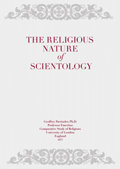I must make it clear that I am not a Scientologist. On the contrary, I am an ordained Methodist Minister of over 40 years1 standing. I have no brief for the beliefs and practices of Scientology and might be critical of some of them. But I am concerned with religious freedom, which is essential to a democratic society.
In 1971 I was approached by representatives of Scientology, since my interest in the meaning of religion was known from my writings and my position as Professor of the Comparative Study of Religions in the University of London. I examined literature sent to me and I thought it well to gain firsthand information by meeting representatives of the movement several times and visiting their British headquarters.
Saint Hill Manor, East Grinstead, is an old enlarged building with adequate but not very extensive grounds. My visit had been arranged but, as often happens, I arrived half an hour early and was able to wander round on my own for some time. From rumours about the Scientologists, I half imagined that there would be a guard at the entrance, or even guard dogs, but everything was open and I drove unnoticed into the car park. Then I went into buildings where students were at work, saw class rooms open, and finally entered the chapel which was like many a Free Church building.
Pictures of Ron Hubbard were in many places and texts on the walls almost indicated his presence, such as “Don’t rush, you might run into Ron”. When the choir entered the chapel some striking words occurred in their processional hymn: “This man alone, made the way known”. There sounds the voice of religious dogmatism. It may be that, like the Buddha, Ron Hubbard will be invested with supernatural authority and even become a deity, in function if not in theory. But there are other articles of faith which run counter to this tendency. The Sunday afternoon service was crowded, with people of all ages, who were cheerful and responsive. Mr. Justice Ashworth noted that “The minister confronts the people and says hello to them” but this is common in churches of various denominations. The minister wore a clerical collar and a sort of cross or ankh, but these are trappings of religion, not its substance. There were hymns, a time of quiet which included a prayer, and a sermon which mentioned God several times.
1. Professor Parrinder wrote this paper in 1977.





























